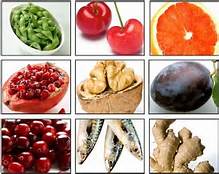Reduce Inflammation By Igniting Your Passion for Healthy Eating

The word inflammation is derived from a Latin word meaning “to kindle” or “to ignite”. Inflammation is part of your immune system, the body’s attempt at self-protection, and is designed to remove harmful stimuli and begin the healing process. There are two kinds of inflammation, acute and chronic. Acute inflammation starts rapidly and quickly becomes severe, and includes symptoms such as pain, heat, redness, swelling, and loss of function. Injury, irritation such as a sore throat, surgery, and even exercise, are examples of acute inflammation. Without inflammation, infections, wounds and any damage to tissue would never heal.
Chronic inflammation, on the other hand, can eventually cause several diseases and conditions, including some cancers, arthritis, atherosclerosis and hay fever. Plaque in coronary artery disease is linked to inflammation. Scientists from Stanford University found that people with coronary artery disease, the leading cause of death globally, are most likely predisposed to the disease because they have a genetic link to inflammation.
So what causes inflammation?
Poor sleep. Scientists at Emory University School of Medicine found that sleep deprivation or poor sleep quality raises inflammation, which increases risk of developing heart disease and stroke.
Obesity. Fat men have more white blood cells, a marker for inflammation, than men of the same age who are not obese or overweight. Postmenopausal overweight or obese women who lost 5% or more of their body weight saw a measurable decline in levels of inflammation markers.
Uncontrolled diabetes. Inflammation in various parts of the body are likely if diabetes is not well controlled.
Allergies. All allergies have inflammation. Asthma – inflammation of the airways; hay fever – the nose, ear and throat mucous membranes. People who are allergic to bee stings may have serious life-threatening inflammation which affects the whole body, called anaphylaxis.
Vitamin A deficiency. A lack of vitamin A has been linked to inflammation in the intestines, lungs and skin. Taking vitamin A supplements could help reduce the deficiency found in conditions like inflammatory bowel disease, acne and lung disease. Good sources of vitamin A include milk, fortified nondairy alternatives like soy milk, yogurt, hard cheeses, fortified cereals and kale.
Combating inflammation may be possible through a healthy diet. Ginger, turmeric, fish oil, green tea, and tart cherries are all purported to have anti-inflammatory properties. Studies show that ginger was found to reduce the markers of colon inflammation, associated with a higher risk of developing colon cancer and may help prevent colon cancer. Turmeric may be beneficial in treating arthritis and Alzheimer’s disease. Other good choices for reducing inflammation include tomatoes, beets, dark leafy greens, garlic, onions and berries.
It is as important to know what foods cause inflammation as it is to know what foods prevent it. Processed, packaged, prepared foods and fast food top the list of inflammatory foods, thanks to the harmful oils, sugar, artificial sweeteners and food additives. Hydrogenated and trans fats found in margarine, shortening, lard or products made with them. White sugar, sweets and synthetic sweeteners are highly inflammatory.
Bottom line: when it comes to inflammation, ignite your passion for healthy eating to reduce the undesired inflammatory responses from your body.










